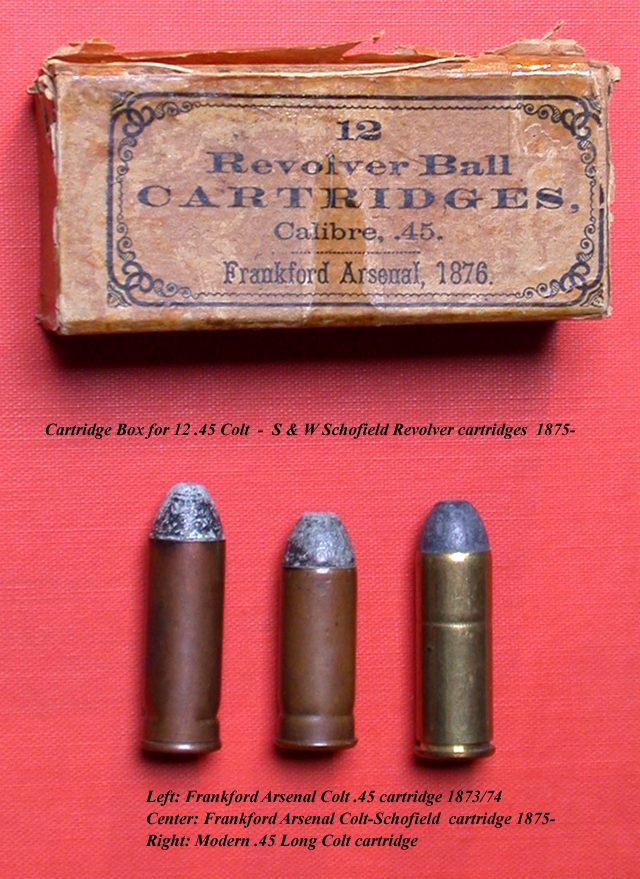.45 Schofield on:
[Wikipedia]
[Google]
[Amazon]
 The .45 Schofield, also referred to as .45 Smith & Wesson is a
The .45 Schofield, also referred to as .45 Smith & Wesson is a
.45 Schofield Revolver
* Schofield, G. W., "Revolving Fire-Arm", Issued 1873 {{DEFAULTSORT:45 Schofield Pistol and rifle cartridges Military cartridges Smith & Wesson cartridges
revolver
A revolver (also called a wheel gun) is a repeating handgun that has at least one barrel and uses a revolving cylinder containing multiple chambers (each holding a single cartridge) for firing. Because most revolver models hold up to six ...
cartridge developed by Smith & Wesson
Smith & Wesson Brands, Inc. (S&W) is an American firearm manufacturer headquartered in Springfield, Massachusetts, United States.
Smith & Wesson was founded by Horace Smith and Daniel B. Wesson as the "Smith & Wesson Revolver Company" in 185 ...
for their S&W Model 3 Schofield top-break revolver. It is similar to the .45 Colt round though shorter and with a slightly larger rim, and will generally work in revolvers chambered for that cartridge; the converse is not true, since the .45 Colt case is longer. US government arsenals supplied .45 Schofield cartridges for the Schofield revolver and the Colt Army revolver to simplify their armament needs.
History
This cartridge was originally designed as ablack powder
Gunpowder, also commonly known as black powder to distinguish it from modern smokeless powder, is the earliest known chemical explosive. It consists of a mixture of sulfur, carbon (in the form of charcoal) and potassium nitrate ( saltpeter). T ...
round. The Schofield revolver (a variant of the Smith & Wesson Model 3) was patented in the USA on 20 June 1871 and 22 April 1873 by Smith & Wesson. It was a Smith & Wesson Model 3 that was modified, due to a suggestion by Major George Schofield, to make it easier for a cavalryman to reload while riding. While the Colt 45 had more power, the speed at which a cavalryman could reload a Schofield was less than 30 seconds, half of the time for a Colt 45. By 1879, the U. S. Army had purchased 8,285 of the revolvers. Due to its reduced power and recoil compared to the Colt .45, it was easier to shoot accurately, yet still retained effective stopping power on the battlefield. It became the standard cartridge of the Army, though the Colt 1873 still was the main issue side arm of the Army.
The .45 Schofield cartridge was shorter than the .45 Colt. It could be used in both the Schofield and the Colt 45 Peacemaker, but the .45 Colt was too long to use in the Schofield. As a result, by the late 1880s the army finally standardized on a .45 cartridge designed to fire in both revolvers, the M1887 Military Ball Cartridge. The M1887 was made at Frankford Arsenal, and was issued only to the military. It had the shorter case of the Schofield and the reduced rim of the Colt round; as it was short enough to fit the Schofield, and its rim was not needed for the rod-ejector Single Action Army, the M1887 would fire and eject from both revolvers.When the Army began to adopt modern side-loading double-action revolvers, the M1887 round gave occasional ejection trouble, and was replaced in Army use by the M1909 .45 Colt cartridge.
The Schofield was quite a popular handgun in the old west, and may have been used by General Custer at the Battle of the Little Bighorn
The Battle of the Little Bighorn, known to the Lakota and other Plains Indians as the Battle of the Greasy Grass, and also commonly referred to as Custer's Last Stand, was an armed engagement between combined forces of the Lakota Sioux, N ...
. The effectiveness of the cartridge in battle, and its reputation for shootability and accuracy, led to the duplication of the cartridges' characteristics in the .45 ACP.
In the early 1880s the Benet type (internal) cartridge primer was retired and the modern Boxer type (external) primer was adopted for all future military production of revolver ammunition.
Synonyms
*.45 S&W *.45 S&W Schofield *.45 M1877 ball revolverSee also
* * *References
External links
.45 Schofield Revolver
* Schofield, G. W., "Revolving Fire-Arm", Issued 1873 {{DEFAULTSORT:45 Schofield Pistol and rifle cartridges Military cartridges Smith & Wesson cartridges